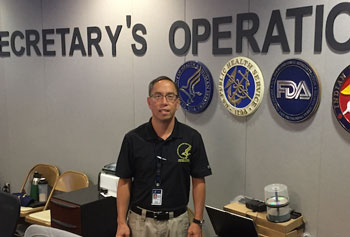JABSOM alumnus helps lead part of Harvey and Irma response
 By Tina Shelton
By Tina Shelton
University of Hawaiʻi medical school alumnus Dr. Douglas M. Char just completed three weeks responding to Hurricanes Harvey and Irma. Dr. Char, a 1989 graduate of the John A. Burns School of Medicine (JABSOM), is a Professor of Emergency Medicine at the Washington University School of Medicine in St. Louis. But it is his role as Team Medical Director for the Midwest Disaster Medical Assistance Team (DMAT) that took him into the communities coping with the hurricanes.
DMATs are a federal resource within the National Disaster Medical System that operates under the auspices of the Office of Emergency Management, Assistant Secretary for Preparedness and Response (Department of Health & Human Services). The team consists of 36 people, who are equipped to be self-sufficient for 72 hours. They are supplied with medical equipment, medicine and ventilators, and generally when deployed, they set up and operate out of tents.
“I went out with my team and staged in Dallas after being activated for Harvey,” said Dr. Char. “I was transferred to the regional command center in Austin, to help oversee the federal health response for the Chief Medical Officer.”
Instead of preparing to staff a field hospital, Dr. Char was assigned to provide oversight and medical consultation to the coordinating team, made up of Texas state medical and other federal health authorities, including representatives of the Centers for Disease Control (CDC), Substance Abuse and Mental Health Administration (SAMSHA) and the Food & Drug Administration (FDA).
“Once deployed we are generally out for two to three weeks,” said Dr. Char, (JABSOM Alumnus). “As Harvey response operations transitioned to the recovery phase, I was moved to Washington, DC to help staff the Health & Human Services Secretary’s Operation Center.”
Dr. Char spent a week assigned to the Chief Medical Officer’s desk as part of the Emergency Management Group. His work involved collaborating with other federal partners, analyzing medical data from the field, looking for public health trends, providing “medical” interpretation of data coming into the operation center from multiple sources.
“Having previously staffed an IRCT as a former Regional Deputy Chief Medical Officer for NDMS (Region VII – Kansas, Nebraska, Iowa, and Missouri), the novel part of this deployment was spending time in Washington, DC,” he said. “I have gained a new understanding of the complexity and challenges involved in preparing for and responding at the national level for events like Hurricane Harvey and Irma (and now Maria).”
“Mind-boggling” complexity
As a field responder in the past, Dr. Char recalls thinking that it took too long to get sent out and set up. “Now I know just how many people are involved and how hard they are working to try and help our friends and neighbors dealing with a devastating disaster,” said Dr. Char. “It’s quite mindboggling, what’s involved and the layers of authority, challenges logistical support, including flying everything into Puerto Rico, the complexity of deciding who to send, where to send them, how to send them and determining what equipment and supplies they need to be successful, how to resupply the teams once they are out, security concerns, and finally – finances.
Dr. Char noted that “Hawaiʻi-1” is also an NDMS team (based in Honolulu); they spent two weeks on the job in Key West, Florida.
